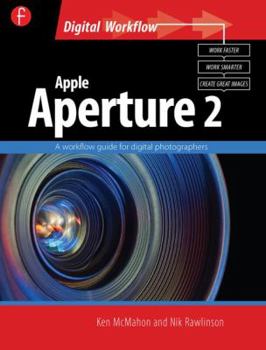Apple Aperture 2: A Workflow Guide for Digital Photographers
Apple's Aperture software is a post-production tool designed to allow digital photographers to import, manage and enhance photographs in one simple, integrated workflow. Aperture 2, the recently... This description may be from another edition of this product.
Format:Paperback
Language:English
ISBN:0240520394
ISBN13:9780240520391
Release Date:October 2008
Publisher:Focal Press
Length:368 Pages
Weight:2.00 lbs.
Dimensions:0.9" x 7.4" x 9.6"
Customer Reviews
5 ratings
Handy Resource
Published by Thriftbooks.com User , 14 years ago
This book should have been included with Aperture 2.0. It's a great resource and how to book. I recommend it all people new to the program
Excellent Book
Published by Thriftbooks.com User , 14 years ago
This is by far the best book I have found on Aperture 2! This book covers everything you need to know about the program AND has great info on digital photography (i.e. raw files). Highly recommend!
good book but could be better
Published by Thriftbooks.com User , 15 years ago
The interesting thing that is "off" in this book is the photos/images are actually too small and faint to clearly see them. The test around the images is a pale gray that is very difficult to read. The content is good though, and it has been helpful for me to review this book as I take Apple tutorials.
The book you need
Published by Thriftbooks.com User , 15 years ago
This is the book that Aperture 2 users need. It goes far beyond the Apple Pro Training Series: Aperture 2 book (which isn't exactly bad, but is very short on detail). McMahon and Rawlinson's book matches the best of the Lightroom books, taking a photography rather than computing perspective. For example, the Pro Series book has about 1 paragraph on sharpening, and this basically tells you where the sliders are. Here, the authors dedicate at least 8 pages to explaining the various options, and how they interact. They provide a very nice tutorial on how to extract maximum dynamic range from a RAW file, balancing the boost, exposure and recovery sliders (and more), really putting Aperture through its paces and revealing considerable hidden depths. On the DAM side they are equally thorough, although in this case the Pro Training Series book does a pretty good job too. However, across the board, "Aperture 2: A workflow guide for digital photographers" either equals or considerably surpasses "Apple Pro Training Series: Aperture 2". I haven't read any other Aperture 2 books, but certainly as a general, in-depth guide, it is difficult to see how it could be beaten.
Look no further - this is the Aperture 2 book you want in your arsenal
Published by Thriftbooks.com User , 15 years ago
If you are looking for a solid reference book for the Apple Aperture 2 product, look no further. The Apple Aperture 2 book by Ken McMahon and Nik Rawlinson, published by Focal Press, is an excellent choice. This is the second book on Aperture 2 that I've seen hit the shelves so far, and this one is a keeper. The book's writing style is straightforward, well organized, and the authors do a fine job in giving the reader comprehensive coverage of Aperture 2 and related areas. The first chapter is all about RAW images - over 20 pages of details that describe all you wanted to know about RAW, including advantages and disadvantages of a RAW workflow as well as technical detail about what RAW means. I think this was an excellent introduction into the world of Aperture, and it really assists the reader in understanding what's going on in Aperture. The book then introduces Aperture and its workspace in Chapter 2. The 3rd Chapter discusses the important topic of image management, including importing images, vault usage, referenced files vs. managed files, etc. Chapter 4 discusses the fine points of metadata usage in Aperture. Chapter 5 goes into the nitty gritty image adjustment features. Chapter 6 talks about Aperture workflow. Chapter 7 then discusses how to use Aperture with other applications, such as Photoshop and plug-in tools, as well as how to migrate from using Bridge or iPhoto. The final 8th Chapter discusses output, from exporting and printing, to the slideshow feature. The book offers a very practical perspective in how best to use the Aperture 2 software, in addition to describing the features of the software. For example, the book talks about practical backup strategies for your photo library, migration strategies from other photo management tools, workflow considerations when using external photo editing tools, creating books using Aperture but then using a different tool to output your book, and reasons why one might create separate Aperture libraries. I'm self-taught in Aperture 2 and have been using the tool for about 8 months. I now consider myself an intermediate user, and I still picked up many good tips from the book, some of which are listed below (I should mention that the book offers very good coverage of all the features of Aperture for a beginner user. Since I know how to use many of these features already, I'm not making mention of them here): 1. I didn't have a strong understanding about RAW even though I follow a RAW workflow, and Chapter 1 of this book gave an excellent overview. I have to admit, I didn't read this chapter until after I went through the rest of the book because 20+ pages of RAW material didn't sound too interesting, but I was pleasantly surprised! I had seen the RAW adjustment sliders in Aperture, but really never understood how they were preset for me and I never was quite sure if I should muck with them. Now, I have a basic understanding of them. And, this chapter finally explained the reason




